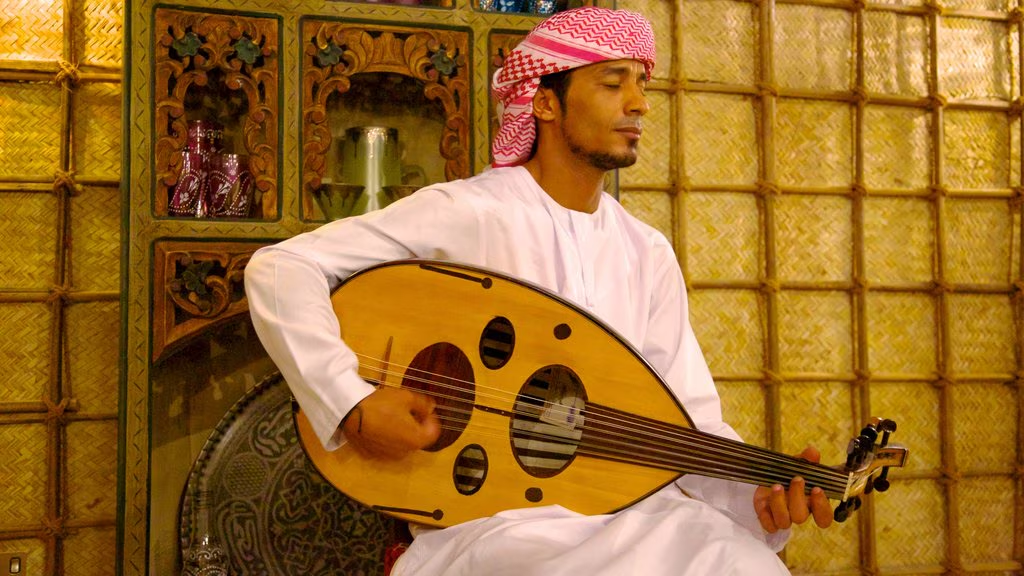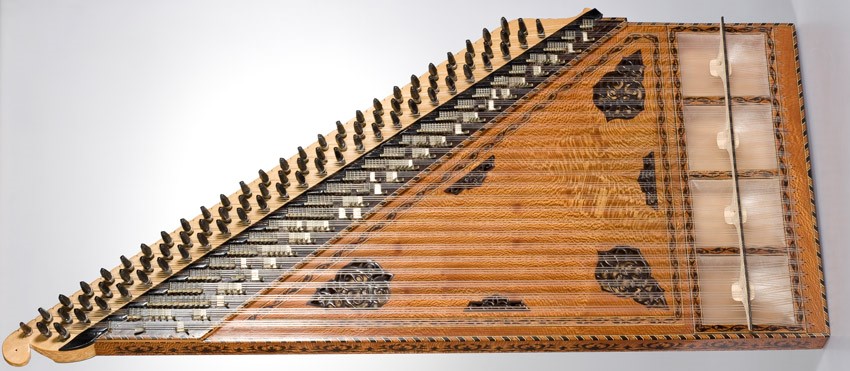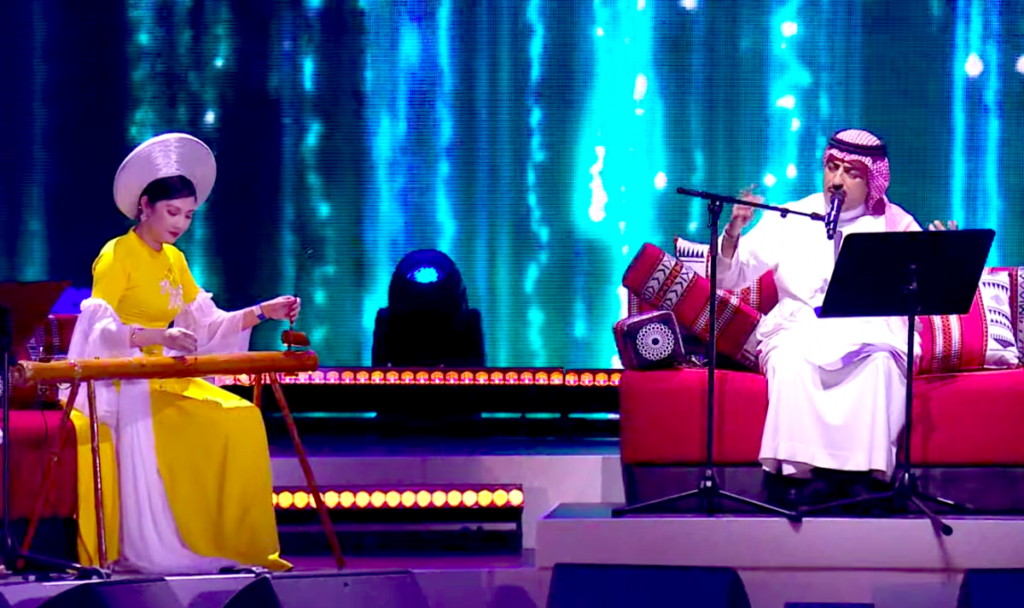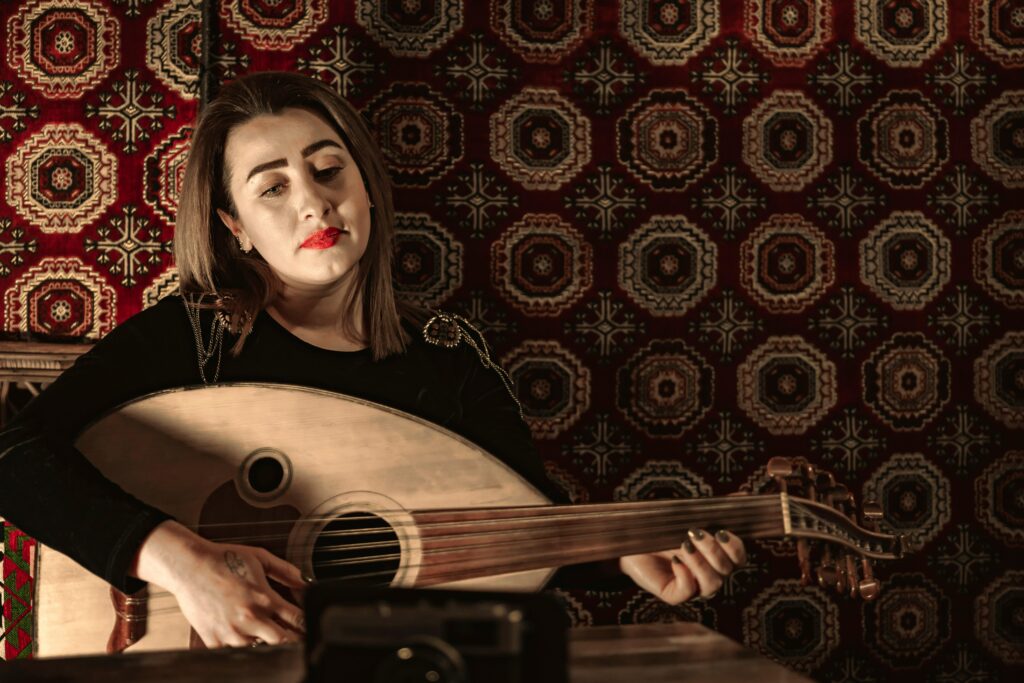Exploring Arabic Music: History, Genres, Instruments, and Global Influence
Estimated reading time: 13 minutes
Key Points
- Arabic music is a rich cultural treasure, influenced by Persian, Ottoman, Andalusian, and other cultures.
- The maqām system (complex melodic modes with microtones) is the core theoretical foundation.
- Main genres include classical music based on Maqām, Andalusian, Raï, Gnawa, Khaleeji, Shaabi, and many other regional styles.
- Important traditional instruments include the Oud, Qanun, Nay, and Riq.
- Arabic music varies by country (Egypt, Lebanon, Iraq, Maghreb, Gulf region) and influences world music (Flamenco, Jazz, World Music).
- Modern times have seen the development of fusion genres (Arabic Pop, Electronic, Hip Hop) alongside the preservation of traditional music.
Table of Contents
- General Introduction
- History and Origins of Arabic Music
- Traditional Arabic Music Genres
- Traditional Instruments in Arabic Music
- Arabic Music in Different Countries
- Influence of Arabic Music on the World
- Famous Artists and Bands
- Arabic Music in the Modern Era
- How to Enjoy and Learn Arabic Music
- Conclusion
- Frequently Asked Questions (FAQ)
General Introduction
Arabic music is a rich and diverse cultural treasure that spans from the Arab Peninsula to North Africa. It is not just melodies, but also the voice of history, soul, and identity of peoples in the Arab world. Exploring traditional Arabic music is key to a deeper understanding of the unique cultural heritage and history of this region.
In this article, we will explore the fascinating journey of Arabic music. We will start from the ancient origins, learn about distinctive genres, get acquainted with unique traditional instruments, explore the transformations of music across various countries, and ultimately recognize its powerful influence on the international stage. Get ready to immerse yourself in this mysterious and captivating world of melodies.

History and Origins of Arabic Music: A Journey Through the Centuries
The origins of Arabic music are not found in a single location but in a cultural crossroads where Arab and Islamic empires intersected. It is a blend of many influences, from ancient Persia, the powerful Ottoman Empire to the brilliant Andalusian heritage in Islamic Spain. This mix has created a unique musical foundation that is both complex and captivating.
One of the golden ages of Arabic music was the Islamic Golden Age. Under the patronage of art-loving rulers, music flourished. Cities like Baghdad and Córdoba (in Al-Andalus) became major music centers where musicians, theorists, and poets came together to create and shape classical music schools. Important theoretical works on music also emerged during this period, laying the foundation for later developments. According to historical records, music served not only as entertainment but also played significant roles in rituals, court life, and even in science, as part of mathematics and philosophy in major academic centers like Baghdad and Al-Andalus.
The evolution of Arabic music did not occur in isolation. Interactions with other cultures, particularly during the colonial period of Western powers, brought new elements. Exposure to Western harmonies, instruments, and song structures enriched the sound palette of Arabic music, though sometimes sparking debates about preserving traditional identities. This cultural exchange is an integral part of the evolutionary story of regional music.
An important branch worth mentioning is the Andalusian tradition. After the Muslims withdrew from Spain, this refined musical heritage followed immigrants to North Africa and took deep root here. Especially in Morocco and Algeria, Andalusian music has been preserved and developed, becoming an essential part of the music identity of the Maghreb region. The music of this land, with its delicate melodies and complex structures, serves as a vibrant testament to centuries of cultural fusion.
The core theoretical foundation of Arabic music is the maqām system. This is not simply a Western-style scale but a complex system of melodic modes that include characteristic intervals (often with microtones), accented notes, and even accompanying moods or emotions. The maqām system, which may predate Western music, is key to understanding the richness and sophistication in melodies of Arabic music. It allows musicians to express a multitude of emotional nuances, from joyful and grand to profound and mournful.
Traditional Arabic Music Genres: Diversity in Melodies
Arabic music is not a singular entity but a colorful tapestry with countless genres reflecting the cultural, geographical, and historical diversity of the vast Arab world. Each genre carries its own mark, a unique story that contributes to the richness of this musical heritage. Below are some representative genres:
- Maqām (and genres based on Maqām): As mentioned, maqām is the foundational theoretical system. However, it also shapes classical music genres. Arabic classical music, often performed by small ensembles known as takht, utilizes maqām to construct complex works requiring high technical skill and adept improvisation (taqsim). Popular forms include samai, bashraf (often of Ottoman origin), and qasidah (classical poetry singing). Music based on maqām focuses on developing melody and expressing subtle emotions.
- Andalusian Music: This is a precious legacy from the Islamic period in Spain (Al-Andalus). This genre is primarily popular in North African countries such as Morocco, Algeria, and Tunisia, where it goes by different names like al-Āla in Morocco or Malouf in Tunisia and Algeria. Characterized by its refinement, tight structure (often in the form of suites called nawba or nuba), and the use of instruments like the oud, rebab (two-stringed fiddle), and hand drums, its melodies often evoke a refined, nostalgic atmosphere of a golden era.
- Raï: Originating from the city of Oran in Algeria in the early 20th century, Raï initially was the folk music of nomadic Bedouins. It later evolved into an urban genre, blending traditional Arabic, Berber musical elements with influences from French pop, rock, reggae, and funk. Raï is known for its straightforward lyrics, often touching upon social issues, love, and everyday life. Artists like Cheb Khaled and Cheb Mami brought Raï to international prominence in the 1980s and 1990s. Its vibrant rhythms and unique blend of tradition and modernity highlight this genre.
- Gnawa: Originating from West African slaves brought to Morocco, Gnawa is a unique spiritual music genre. It combines complex rhythms from sub-Saharan Africa, Sufi ritual elements, and indigenous Berber musical traditions. Gnawa music is often used in healing ceremonies (lila), featuring characteristic instruments like guembri (three-string bass made from skin) and qraqeb (large metal castanets). The mesmerizing, repetitive sound of Gnawa, along with its dances and colorful costumes, creates a powerful musical and spiritual experience. Today, Gnawa is also fused with jazz, blues, and rock by many Moroccan and international artists.
Additionally, there are many other regional styles like Khaleeji (Persian Gulf music with distinctive rhythms), Shaabi (urban folk music of Egypt), Tarab (a state of ecstasy, emotional elevation when listening to classical Arabic music),… Each genre adds a unique brushstroke to the overall picture of Arabic music.

Traditional Instruments in Arabic Music: The Soul of Melodies
The distinctive and captivating sound of Arabic music is inseparable from its unique traditional instruments. These instruments not only create melodies but also serve as a medium to express the complexities of the maqām system and convey subtle emotional nuances. Below are some of the most important instruments:
- Oud: Known as the “king of instruments” in the Arab world, the Oud is a pear-shaped lute with a short neck and no frets. The absence of frets allows players to create characteristic microtones of the maqām system. The Oud typically has 11 or 13 strings (5 or 6 pairs of double strings and a single bass string). The warm, resonant sound of the Oud plays a central role in most Arab orchestras, fulfilling both melodic and harmonic accompaniment roles. It is an ideal instrument for both improvisational solo performances (taqsim) and ensemble play.
- Qanun: A trapezoidal zither, the Qanun has a clear, crisp, and very rich sound. It typically has around 78 strings, stretched in groups of three strings for each note. Players use plectra attached to their fingers to create melodies. Notably, the Qanun features small levers called mandal under each group of strings, allowing players to quickly change pitch to create the microtones of maqām. The Qanun often takes the lead melody, creating ornamented phrases that showcase technical skill and add sparkle to the music.
- Nay: A vertical flute typically made from reed, the Nay is one of the oldest instruments in the Middle East. The sound of the Nay is rustic, deep, and full of emotion, often compared to the sighing of the soul. Playing the Nay requires intricate techniques, demanding subtle control over breath and lip positioning to produce various notes and microtones. The Nay is commonly used in classical, folk, and Sufi religious music, providing moments of tranquility and reflection.
- Riq: A small handheld drum resembling a tambourine, the Riq plays a crucial role in creating and maintaining the complex rhythms (iqa’at) of Arabic music. The drum frame is often made of wood, beautifully inlaid, with pairs of small metallic jingles attached around. Riq players use a variety of intricate finger techniques to create a range of timbres, from the deep thump of the drum surface to the jingling sound of the jingles. A master Riq artist can produce incredibly intricate rhythmic patterns, providing a solid foundation for melodic development.
In addition, many other instruments contribute to enriching the sound of Arabic music, such as Darbuka (goblet drum), Buzuq (long-neck lute), Rebab (two-string fiddle), and wind instruments like Mizmar. The masterful combination of these instruments, guided by the maqām and iqa’at systems, creates a unique soundscape that is both steeped in history and full of life.
Arabic Music in Different Countries: Regional Identities
Although sharing a common theoretical foundation of maqām and many traditional instruments, Arabic music showcases unique and distinct identities in each country, each region https://nuhaira.com/cac-quoc-gia-noi-tieng-a-rap. These differences reflect the history, culture, local languages, and distinct external influences.
- Egypt: Considered one of the power centers of Arabic music, especially in the 20th century. Egypt is famous for the Tarab tradition – the ability to evoke intense emotions, ecstasy for listeners through powerful vocals and skilled improvisation. Legendary singers like Umm Kulthum, Abdel Halim Hafez, and Mohamed Abdel Wahab shaped the classic and romantic Egyptian music style. Additionally, Egypt has the lively Shaabi genre, reflecting the everyday lives of urban populations and is the cradle of the Arab film and pop music industry. Large orchestras (firqa) with many Western instruments combined with traditional instruments are also a feature of modern Egyptian music.
- Lebanon: Situated at the crossroads of the Mediterranean, Lebanon boasts a sophisticated music scene that combines Arabic traditions with European influences, particularly from France. Lebanon is home to legendary singers like Fairuz, known for her angelic, pristine voice, often performing songs composed by the Rahbani brothers with profound lyrics and melodies that blend Eastern and Western styles. The likes of Sabah and Wadih El Safi are also significant figures. In addition to lyrical ballads and classical music, Lebanon is a major hub for contemporary Arabic pop (Arabic Pop), featuring famous stars and meticulously produced music that aligns with global trends.
- Iraq: This ancient land of Mesopotamia has a rich and long-standing musical heritage. Iraq is most famous for Maqām Iraqī, a distinct maqām style considered one of the most refined and scholarly forms of Arabic classical music. Maqām Iraqī has complex structures, its own maqām system, and is often performed by a singer (qari’) with a small orchestra called Chalghi Baghdadi, featuring characteristic instruments such as Joza (gourd fiddle) and Santur (Hammered dulcimer). Iraqi culture in general has greatly contributed to the development of Arabic art and music over the centuries.
- Maghreb Region (North Africa – Morocco, Algeria, Tunisia, Libya): This area features a unique blend of Arab, indigenous Berber, and Andalusian heritage. As mentioned, Andalusian music is very popular here. In addition, genres such as Raï (Algeria), Gnawa (Morocco), and Malouf (Tunisia, Libya) each carry their own distinct characteristics. The music of nomadic peoples and ancient war dances has also left a mark on the region’s folk music, especially in Morocco.
- Gulf Region (Khaleej – Saudi Arabia, Kuwait, UAE, Qatar, Bahrain, Oman): Gulf music, or Khaleeji, has characteristic rhythms, often using complex percussion and clapping. Vocals often feature unique melismatic techniques. Traditional dances like Ardha are also associated with the music of this region.
This diversity shows that Arabic music is constantly evolving and developing, with each region contributing unique colors, enriching the common heritage of the entire Arab world.
Influence of Arabic Music on the World: Melodies Across Borders
The appeal of Arabic music is not limited to the Arab world; it also permeates and profoundly influences many other music traditions worldwide. From theoretical systems to specific genres and instruments, the fingerprints of Arabic music can be found in surprising places.
- Influence on Other Eastern Music: The maqām system of Arabic music is closely linked to and mutually influences other modal music systems in the Middle East and Central Asia. Turkish classical music (Makam) and Persian music (Dastgah) share many similarities in concepts and melodic structures with maqām Arabic, although each system has its unique traits and nomenclature. The long-standing cultural interactions between Islamic empires have facilitated the shared exchange and development of these musical traditions.
- Influence on Western Music:
- Spanish Music and Flamenco: The Andalusian musical heritage, rich in Arabic influences, has existed in Spain for centuries and has left an indelible mark on Spanish folk music, especially Flamenco. Elements such as modal melodies (Phrygian scale), melismatic vocal techniques (melisma), and the presence of instruments like the guitar (which originated from the Oud) all indicate a deep historical connection.
- Jazz: Some researchers and musicians argue that the modal elements present in Arabic music and other Eastern music traditions have indirectly influenced the development of modal jazz in the mid-20th century. Jazz musicians like John Coltrane and Miles Davis explored scales and melodic structures that went beyond traditional Western harmonic systems, seeking inspiration from other cultures. The fusion between Raï and Jazz is also an example of an intriguing combination of two musical worlds.
- World Music and Fusion: In the era of globalization, Arabic music has become increasingly prominent on the global music stage. Contemporary Arab artists frequently collaborate with musicians from around the world, creating unique fusion genres. The sounds of Oud, Qanun, Nay, or characteristic Arabic rhythms are combined with Pop, Rock, Electronic, Jazz, and other folk music styles, resulting in fresh and exciting musical experiences. International music festivals also regularly showcase Arab artists and bands, promoting this heritage to a wider audience.
- Film Music and Media: Arabic melodies and instruments are also often employed in Hollywood film scores and international media products to create Middle Eastern atmospheres or evoke feelings of mystique and adventure. Although this usage can sometimes be clichéd, it also contributes to the public’s familiarity with the distinctive sounds of the region.
The influence of Arabic music shows its vibrant vitality and capacity to transcend cultural borders. These melodies are not just a heritage of the Arab world but also an essential part of the diverse musical landscape of humanity.

Famous Artists and Bands: Icons of Arabic Music
To gain a deeper understanding of Arabic music, one cannot overlook the artists and bands that have shaped, developed, and elevated this genre. They are not only talented performers but also cultural icons, significantly influencing the spiritual lives of millions.
- Umm Kulthum (Egypt, 1904-1975): Known as the “Star of the East” (Kawkab al-Sharq), Umm Kulthum is an irreplaceable legend of Arabic music. Her powerful contralto voice, exceptional improvisational skill (taqsim) in marathon performances, and selection of poetic lyrics from great poets made her a national symbol in Egypt and beloved throughout the Arab world. Her concerts, broadcast live on radio on the first Thursday of every month, attracted millions of listeners. Iconic songs like “Enta Omri” (“You Are My Life”) still resonate today. She embodies Tarab – the ability to convey deep emotions to the audience.
- Fairuz (Lebanon, born 1934): One of the most respected and beloved voices in the Arab world, Fairuz (or Fayrouz) is renowned for her angelic, pristine, and poetic voice. She, along with the Rahbani brothers (Assi and Mansour), created a unique musical style blending traditional Lebanese melodies, Arabic influences, and Western harmonies and orchestras. Fairuz’s songs often cover themes of love, homeland, nature, and human values. Her voice is intertwined with the mornings of many Lebanese and the Arab world. Works like “Li Beirut” (“For Beirut”) or the musical shows she participated in have become classics.
- Marcel Khalife (Lebanon, born 1950): A master oud player, composer, and famous singer, Marcel Khalife is known for his socially and politically conscious compositions. He often sets music to the poems of the great Palestinian poet Mahmoud Darwish, creating powerful and moving works. Khalife’s music combines virtuosic oud techniques, traditional Arabic melodies, and creative experimentation. He does not shy away from addressing issues such as freedom, justice, and Palestinian identity, making his music both highly artistic and socially impactful.
- Abdel Halim Hafez (Egypt, 1929-1977): Along with Umm Kulthum and Mohamed Abdel Wahab, Abdel Halim Hafez formed the “golden trio” of 20th-century Egyptian music. He is known as “Al Andalib Al Asmar” (The Brown Nightingale), famous for his romantic, poignant ballads and warm, emotive voice. A renowned film actor, many of his songs have become immortalized through musical films.
- Kadim Al Sahir (Iraq, born 1957): Dubbed the “Emperor of Arabic Music,” Kadim Al Sahir is one of the most successful and beloved singers and songwriters in the contemporary Arab world. He is famous for combining classical Arabic music (including Maqām Iraqī) with modern pop, creating grand and romantic ballads. He also often sets Arabic classical poetry, especially that of Nizar Qabbani, to music.
These are just a few of the many prominent figures who have and continue to bring glory to Arabic music. Listening to their works is a wonderful way to start the journey of exploring this rich musical world.
Arabic Music in the Modern Era: Tradition Meets Innovation
Entering the 21st century, Arabic music is not static but continuously transforms, adapts, and evolves in the context of globalization and technological advancements. Contemporary artists are striving to balance honoring traditional heritage while embracing new musical trends from around the world.
- The Rise of Fusion Genres: One of the most notable trends is the strong development of fusion genres.
- Arabic Pop: This is the most popular genre, merging Arabic melodies and singing styles with the song structures, beats, and production techniques of Western pop. Stars like Nancy Ajram, Amr Diab, and Elissa have achieved great success with this style.
- Arab Electronic/Techno/House: Arab producers and DJs are experimenting by integrating samples from traditional instruments, maqām melodies, or classical vocals into electronic music. This creates a unique dance style that is both modern and heavily influenced by regional identity. Artists like Omar Souleyman (Syria) have gained international attention with their electronic dabke style.
- Arab Hip Hop/Rap: Similar to many other places, Hip Hop has deeply taken root in the Arab youth, becoming a means for them to express views on social, political issues, and personal lives. Rappers use Arabic, blending Hip Hop flow and beats with local musical elements.
- Arab Rock/Metal: Although less popular, there are still Arab Rock and Metal bands combining the powerful sounds of electric guitar, bass, and drums with Arabic scales, melodies, and sometimes even traditional Arab instruments.
- Integration of Western Instruments and Technology: The use of Western instruments like electric guitars, bass, keyboards, and drum sets has become common in many modern Arabic music genres. In addition, studio technology, auto-tune, and digital sound effects are also widely applied in music production, similar to global trends. This helps Arabic music easily reach international audiences, although it sometimes raises concerns about losing traditional identity. This blend is an undeniable reality in the contemporary music scene.
- The Role of the Internet and Social Media: The internet, streaming platforms like Spotify, Anghami, Deezer, and social media like YouTube, Instagram, TikTok have completely changed the way Arabic music is produced, distributed, and consumed. Independent artists can easily reach audiences without relying on major record labels. Musical trends spread rapidly, and interactions between artists and fans have become more direct.
- The Persistence of Traditional Music: Despite significant innovations and experimentation, classical and folk Arabic music still holds a vital position. Many dedicated artists continue to preserve and perform classical forms such as maqām, Tarab, or Andalusian music. Traditional music festivals and educational institutions remain active, ensuring this precious heritage is passed on to future generations.
Arabic music in the modern era is a vibrant picture where tradition and innovation coexist, converse, and sometimes blend, creating diverse and constantly evolving forms of musical expression.
Conclusion: Arabic Music – A Living and Enduring Heritage
Through this exploration journey from history, origins to diverse genres, unique instruments, and iconic artists, we can see that Arabic music is a tremendously valuable and vibrant cultural heritage. It is not merely entertainment but a reflection of the soul, history, and identity of peoples in the vast Arab world.
From the complex maqām system that creates emotional melodies, to the distinctive sounds of Oud, Qanun, Nay, Riq; from the sophistication of Andalusian music, the inner strength of Tarab, to the rebellion of Raï or the spirituality of Gnawa – Arabic music always embodies incredible richness and depth. It has withstood the test of time, continuously evolving, interacting with other cultures, and making significant impacts on the international stage.
In the modern era, despite facing numerous changes and new trends, Arabic music maintains its vibrant life, accompanied by the coexistence of traditional streams and innovative fusions.
We hope this article has provided you with an overview and sparked curiosity about Arabic music. Take the time to listen, learn, and feel the beauty of these timeless melodies. Exploring Arabic music is not just about discovering an art form, but also exploring an essential part of humanity’s cultural heritage. Let these enchanting and mysterious melodies guide you into a colorful and emotional sound world.
Frequently Asked Questions (FAQ)
1. What is Maqām in Arabic music?
Maqām (plural: maqāmāt) is the system of melodic modes in traditional Arabic music. It is more complex than Western scales, including characteristic intervals (often featuring microtones), accent notes, popular melodic patterns, and conventions for melodic development, even the moods or emotions related to it. This is the basis for constructing melodies and improvisation in Arabic music.
2. Which instruments are most important in Arabic music?
Oud (Ud) is often considered the “king” of Arabic instruments due to its central role in expressing melodies and harmonic accompaniment. However, other instruments like Qanun (zither), Nay (flute), and Riq (hand drum) are also extremely important in creating the characteristic sounds of Arabic orchestras and genres.
3. Is Arabic music the same in every country?
No. Although there is a shared theoretical foundation (like maqām) and some instruments, Arabic music displays significant diversity between regions and countries. For example, Egypt is famous for Tarab and Shaabi, Lebanon for its sophisticated blend of East and West, the Maghreb region for Andalusian music, Raï and Gnawa, Iraq for Maqām Iraqī, and the Gulf region for the distinctive Khaleeji rhythms.
4. How can I start listening to Arabic music?
You can start by listening to legendary artists like Umm Kulthum, Fairuz, or famous contemporary artists like Kadim Al Sahir. Use music streaming platforms (Spotify, Anghami, YouTube Music) and search for playlists like “Arabic Classics,” “Arabic Pop,” “Andalusian Music,” or specific artist/genre names. Listen with an open mind and pay attention to the melodies, instruments, and emotions that the music evokes.

